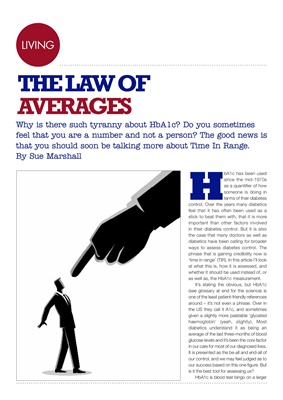
LIVINGLIVING
THE LAW OF
AVERAGESWhy is there such tyranny about HbA1c? Do you sometimes
feel that you are a number and not a person? The good news is
that you should soon be talking more about Time In Range.
By Sue Marshall
H
bA1c has been used
since the mid-1970s
as a quantifier of how
someone is doing in
terms of their diabetes
control. Over the years many diabetics
feel that it has often been used as a
stick to beat them with, that it is more
important than other factors involved
in their diabetes control. But it is also
the case that many doctors as well as
diabetics have been calling for broader
ways to assess diabetes control. The
phrase that is gaining credibility now is
'time in range' (TIR). In this article I'll look
at what this is, how it is assessed, and
whether it should be used instead of, or
as well as, the HbA1c measurement.
It's stating the obvious, but HbA1c
(see glossary at end for the science) is
one of the least patient-friendly references
around - it's not even a phrase. Over in
the US they call it A1c, and sometimes
given a slightly more palatable 'glycated
haemoglobin' (yeah, slightly). Most
diabetics understand it as being an
average of the last three-months of blood
glucose levels and it's been the core factor
in our care for most of our diagnosed lives.
It is presented as the be-all and end-all of
our control, and we may feel judged as to
our success based on this one figure. But
is it the best tool for assessing us?
HbA1c is blood test bingo on a larger